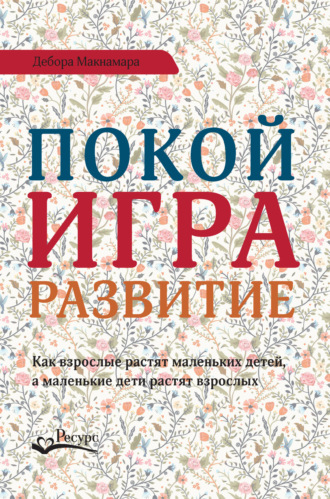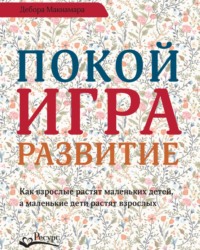
Полная версия
Покой, игра, развитие. Как взрослые растят маленьких детей, а маленькие дети растят взрослых
Не только дети из старшей группы детского сада подвержены большему риску получения диагноза проблем с вниманием, но также, как заявляет Американская Академия педиатрии: «Появляются свидетельства расширения возрастного диапазона, получающего соответствующие рекомендации, и теперь в него входят дети возраста младшей и средней группы детского сада и подростки» (Subcommittee on Attention-Deficit/ Hyperactivity Disorder, ADHD, p. 2). Учитывая отсутствие каких-либо маркеров для СДВГ и то, что диагностика опирается только на описание поведения, незрелость может быть ошибочно принята за нарушение, как утверждает Форд-Джонс; основания для беспокойства вызывают последствия применения стимулирующих препаратов для развития и «ограниченная информация о воздействии и об опыте использования психостимуляторов у детей от 4 до 5 лет» (Ford-Jones, Misdiagnosis of attention deficit hyperactivity disorder).
59
Крейн У., Теории развития. Секреты формирования личности. 5-е международное издание (СПб.: прайм-ЕВРОЗНАК, 2002).
60
Роджерс Фред, Напутственная речь / Middlebury College, Мидлбери, штат Вермонт, май 2001 г., http://www.middlebury.edu/newsroom/commencement/2001.
61
BC Art Teachers’ Association, Honouring Gail Carney (2015), http://bcata.ca/about-us/tribute.
62
Elkind David, Can we play? Greater Good Science Center, University of California, Berkeley (2008), http://greatergood.berkeley.edu/article/item/can_we_play.
63
Elkind David, Can we play?
64
Elkin David, The Power of Play: Learning What Comes Naturally (Cambridge, MA: Da Capo Press, 2007); Nancy Carlsson-Paige, Taking Back Childhood: Helping Your Kids Thrive in a Fast-Paced, Media-Saturated, Violence-Filled World (New York: Penguin, 2009); Peter Gray, Free to Learn: Why Unleashing the Instinct to Play Will Make Our Children Happier, More Self-Reliant, and Better Students for Life (New York: Basic Books, 2013); Beverly Falk, ed., Defending Childhood: Keeping the Promise of Early Education (New York: Teachers College Press, 2012).
65
Madeline Levine, Teach Your Children Well: Parenting for Authentic Success (New York: Harper Perennial, 2013).
66
Elkind David, Can we play?; Kenneth R. Ginsburg, American Academy of Pediatrics Committee on Communications, and American Academy of Pediatrics Committee on Psychosocial Aspects of Child and Family Health, The importance of play in promoting healthy child development and maintaining strong parent-child bonds // Pediatrics 119 (2007): 182–191.
67
Marcy Guddemi, Andrea Sambrook, Sallie Wells, Kathleen Fite, Gitta Selva, and Bruce Randel, Unrealistic kindergarten expectations: Findings from Gesell Institute’s Revalidated Developmental Assessment Instrument, Proceedings from the Annual Conference for Early Childhood Research and Evaluation (2012), http://www.highscope.org/fi les/guddemim_proceedings2012.pdf.
68
Чит-код (англ. cheat code, cheat – жульничество, обман) – иногда отладочный код, который может быть введен в программу, чтобы изменить ход ее работы. Чаще всего применяется в компьютерных играх для прохождения трудных этапов.
69
Винникот Д. В., Игра и реальность (М.: Ин-т общегуманитарных исслед., 2012).
70
Твен Марк, Приключения Тома Сойера (1876; М.: Махаон, 2014).
71
G. Stanley Hall, Adolescence: Its Psychology and Its Relations to Physiology, Anthropology, Sociology, Sex, Crime, Religion and Education (New York: D. Appleton, 1904), p. 235.
72
Piaget’s Developmental Theory: An Overview, feat. David Elkind, videocassette (San Luis Obispo, CA: Davidson Films, 1989).
73
Браун Стюарт и Воган Кристофер, Игра: как она влияет на наше воображение, мозг и здоровье (М.: МИФ, 2015); Pam Schiller, Early brain development research review and update, Brain Development: Exchange (November/December 2010): 26–30; Jaak Panksepp and Lucy Biven // The Archaeology of Mind: Neuroevolutionary Origins of Human Emotions (New York: W. W. Norton, 2012); Joe L. Frost, Neuroscience, play, and child development, paper presented at the IPA/USA Triennial National Conference, Longmont, CO, June 18–21, 1998.
74
Браун Стюарт и Воган Кристофер, Игра…; Frost, Neuroscience, play, and child development.
75
Campaign for a Commercial Free Childhood, Alliance for Childhood, and Teachers Resisting Unhealthy Children’s Entertainment, Facing the Screen Dilemma: Young Children, Technology and Early Education (Boston: Campaign for a Commercial-Free Childhood; New York: Alliance for Childhood, 2012).
76
Bruce D. Perry, Lea Hogan, and Sarah J. Marlin, Curiosity, pleasure and play: A neurodevelopmental perspective // Haaeyc Advocate 20 (2000): 9–12.
77
Perry, Hogan, and Marlin, Curiosity, pleasure and play.
78
Ginsburg et al., The importance of play.
79
Frost, Neuroscience, play, and child development.
80
Jaak Panksepp, Brain emotional systems and qualities of mental life, in Diana Fosha, Daniel J. Siegel, and Marion Fried Solomon, eds., The Healing Power of Emotion: Affective Neuroscience, Development, and Clinical Practice (New York: W. W. Norton, 2009), рр. 1–26.
81
Ginsburg et al., The importance of play.
82
Ginsburg et al., The importance of play; Panksepp, Brain emotional systems; Peter Gray, The decline of play and the rise of psychopathology in children and adolescents // American Journal of Play 3 (2011): 443–63.
83
Falk, ed., Defending Childhood.
84
Sandra L. Hofferth and John F. Sandberg, Changes in American children’s time, 1981–1997 // Advances in Life Course Research 6 (2001): 193–229.
85
Ginsburg et al., The importance of play.
86
Campaign for a Commercial Free Childhood et al., Facing the Screen Dilemma.
87
American Academy of Pediatrics, Media and children (2015), https://www.aap.org/en-us/advocacy-and-policy/aap-health-initiatives/pages/media-and-children.aspx.


